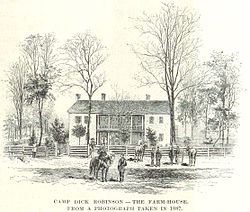Camp Dick Robinson
|
Camp Dick Robinson Headquarters
|
|
|
Formerly listed on the U.S. National Register of Historic Places
|
|

The farmhouse at Camp Dick Robinson in 1887
|
|
| Nearest city | Danville, Kentucky |
|---|---|
| Area | 7 acres (2.8 ha) |
| Built | 1850 |
| NRHP Reference # | 76000888 |
| Significant dates | |
| Added to NRHP | December 12, 1976 |
| Removed from NRHP | December 7, 1990 |
In mid-May 1861, U. S. Navy lieutenant William "Bull" Nelson armed Kentuckians loyal to the Union and that soon became the foundation for his receiving authority to enlist 10,000 troops for a campaign into East Tennessee. On August 6, 1861, those recruits marched into Camp Dick Robinson, making it the first Federal base south of the Ohio River. For Col. George C. Kniffen, "the wisdom of President Lincoln commissioning . . . Nelson to organize a military force on the [neutral] soil of Kentucky" prevented making the state a "battle ground for many months" and it thereby changed the whole direction of the war. In 1864, Salmon P. Chase declared in a speech at Louisville "when Kentucky faltered, hesitated" in the early stages of the Civil War, that undecided "status was settled by WILLIAM NELSON, at Camp Dick Robinson." Six years later, Indiana Senator Daniel D. Pratt reported to the U. S. Senate that Camp Dick Robinson "was one of the most noted military encampments of the war. . . . From its admirable locality and advantages, it was almost indispensable for the successful operations of the" Civil War.
With the outbreak of the Civil War in April 1861, a majority of the citizens in the Mercer, Boyle, Garrard, and Casey counties of Kentucky concluded that secession was "destructive of all permanent government and tending only to political chaos and anarchy." During the third week in May, key leaders obtained 700 muskets from U. S. N. Lt. William Nelson, and distributed those arms to loyal Home Guard troops. This gave them the ability to stand up to the secessionist State Guard and emboldened Kentuckians to elect nine of ten Union candidates on the single issue of keeping the state in the Union. That vote, on June 20, convinced Nelson that the charade of neutrality by both sides had ended. Garrard County Judge Allen A. Burton went to Washington and urged President Lincoln to organize Union men into regiments. This idea called for audacious leadership and as Burton started to leave the Executive Mansion, he encountered Lieutenant Nelson and promptly recommended him for that mission. Nelson met with Tennessee senator Andrew Johnson, Secretary of Treasury Salmon P. Chase and others to formulate a plan of support for loyalists in East Tennessee. On July 1, 1861, Nelson was detached from the Navy with instructions to organize a force of 10,000 troops. Two weeks later, Nelson spoke with Union leaders from southeastern Kentucky at Lancaster and Crab Orchard. The later town was conveniently located at the south end of the turnpike in Garrard County and it was at the head of the Wilderness Road some sixty-five miles north of the Cumberland Gap. Nelson chose the old inn at Bryant Springs as his headquarters and it was agreed they would raise thirty companies of infantry and five of cavalry. Thomas E. Bramlette had one company in camp on July 20 and another on July 24, 1861.
...
Wikipedia
